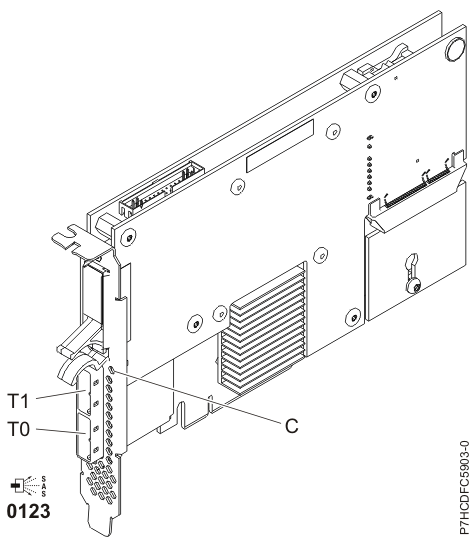PCIe Dual - x4 3 Gb SAS RAID Adapter (FC 5903 and FC 5805; CCIN 574E)
Learn about the specifications and operating system requirements for the feature code (FC) 5903 and FC 5805 adapters.
Overview
The PCI Express (PCIe) Dual - x4 3 Gb SAS RAID Adapter supports the attachment of Serial attached SCSI (SAS) disk and SAS solid-state drives using a pair of mini SAS 4x connectors. The 5903 or 5805 has a 380 MB write cache and a concurrently replaceable cache battery pack. The adapter must always be installed in pairs and is always to be used in a high availability, multi-initiator RAID configuration using two adapters in dual-controller mode. Two 5903 or 5805 adapters provide mirrored write-cache data and mirrored RAID parity footprints between the adapters. If the 5903 or 5805 pairing is broken, then write cache is disabled.
The 5903 or 5805 supports SAS small form factor (SFF) disk drives located in a PCIe 12X I/O Drawer or SAS disk drives located in an EXP 12S Disk Drawer. It can also be connected to the internal disk drives in the system unit using the appropriate split disk backplane feature and cabling.
The adapter is a 3.3 V, PCI-e x8 bootable SAS adapter that provides RAID 0, RAID 5, RAID 6, and RAID 10 for the AIX and Linux operating systems. Under the IBM i operating system, mirroring and data spreading are provided by the operating system, and RAID 5 and RAID 6 are provided by the adapter.
With adequate cabling and configuration, multiple wide ports are used to provide redundant paths to each dual port SAS drive or solid-state drive. The adapter manages SAS path redundancy and path switching in case a SAS failure occur.
The 5903 or 5805 contains a LED ((C) in Figure 1) that flashes if the cache data is present. The cache-data present LED flashes when there is possible data in the cache on the adapter. If the cache data present LED is flashing, do not replace the cache battery pack. If replaced when the LED is flashing, the cache data is lost. See Figure 1 to locate the cache-data present LED on this adapter.
- For Linux operating systems, see Displaying rechargeable battery information.
- For AIX operating systems, see Displaying rechargeable battery information.
- For IBM i operating systems, see Displaying rechargeable battery information.
The following figure shows the adapter.

Specifications
- Item
- Description
- Adapter FRU number
- 46K4735 (Designed to comply with RoHS requirement.)
- Battery FRU number
- 44V7597 (Designed to comply with RoHS requirement.)
- I/O bus architecture
- PCIe x8
- Slot requirement
- One PCIe x8 slot per adapter.
- Adapters are installed in pairs.
- Adapter pairs do not require to be in the same enclosure. For higher availability, place adapters in separate enclosures. See the PCI adapter placement for placement rules.
- Cables
- When you attach 5886 EXP 12S Disk Drawer, at least one of the following SAS (X) cables must be used: 3661, 3662 or 3663.
- SAS device attachment requires specific cables that are provided with the subsystem or device features being attached. Special cabling is required for multi-initiator and high availability configurations. See Serial attached SCSI cable planning.
- Voltage
- 3.3 V
- Form factor
- Short
- Maximum number
- For the maximum adapters supported, see the PCI adapter placement topic collection for your system.
- Attributes
- 48 SAS disk dives supported when the adapter is configured with four 5886 EXP 12S Disk Drawers
- 42 SAS disk drives supported when the adapter is configured with a 19-inch PCIe 12X I/O Drawer and two 5886 EXP 12S Disk Drawers (18 SFF disk drives plus up to 24 SAS disk drives)
- SAS speed: 3 Gbps
- SAS Serial-SCSI Protocol (SSP) and Serial Management Protocol (SMP) are supported
- 380 MB of non-volatile fast write cache can increase disk subsystem performance
- Dual controller supports mirrored-write cache data and mirrored-RAID parity footprints
- Concurrent firmware update supported
- Eight physical links from two mini SAS 4x connectors are provided
- Concurrent replaceable cache battery pack
- Removable media devices are not supported
For details about slot priorities and placement rules, see the PCI adapter placement topic collection for your system.
Operating system or partition requirements
This adapter is supported for the following versions of the operating systems:- AIX:
- AIX 5L™ Version 5.3 with the 5300-07 Technology Level and Service Pack 8, or later
- AIX 5L Version 5.3 with the 5300-08 Technology Level and Service Pack 6, or later
- AIX Version 5.3 with the 5300-09 Technology Level and Service Pack 2, or later
- AIX Version 5.3 with the 5300-10 Technology Level, or later
- AIX 6.1 and Service Pack 8, or later
- AIX Version 6.1 with the 6100-01 Technology Level and Service Pack 4, or later
- AIX Version 6.1 with the 6100-02 Technology Level and Service Pack 3, or later
- AIX Version 6.1 with the 6100-03 Technology Level, or later
- Linux:
- Red Hat Enterprise Linux Version 4, with update 7, or later
- Red Hat Enterprise Linux Version 5, with update 2, or later
- SUSE Linux Enterprise Server 10, with service pack 2, or later
- IBM i
- IBM i 6.1.1 and Resave A, or later, is required for Dual Storage IOA support.
If you are installing a new feature, ensure that you have the software that is required to support the new feature and that you determine whether there are any prerequisites for this feature and attaching devices. To check for the prerequisites, see IBM Prerequisite website .
